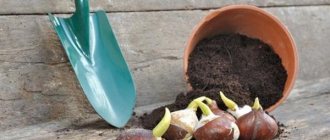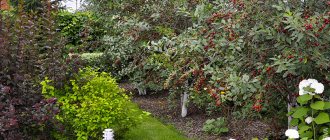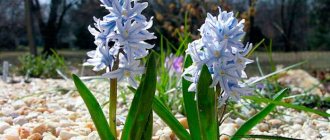Orthodox view
Today, landscape design principles are sometimes even used to decorate burial sites, but you can simply plant some simple, cheap plants on a grave in a cemetery. However, you should not decorate the grave mound with artificial flowers. The Orthodox Church has a negative attitude towards artificial flowers. Artificial flowers are an artificial offering, and during Orthodox holidays even churches are decorated with real, fresh flowers and plants.
Moreover, many priests argue that it is best to plant flowers from your own garden or home on the grave of a loved one, and let them be unsightly or too bright. After all, the deceased does not care what flowers are planted on the grave, and it is better to donate the extra money to the poor.
However, there are general recommendations that are often followed by loved ones of the deceased, regardless of religion or nationality. In Orthodoxy, they take this calmly, because such decoration of graves with perennial flowers and shrubs is needed, first of all, by the relatives of the deceased as a consolation and reassurance of their own souls.
Perennial flowers for the cemetery that do not require care
Among the many perennials, there are flowers that do not require constant care. These are the ones that are most often planted in the cemetery.
Muscari
The bulbous perennial is an early spring flower. Once planted, you don’t have to worry about caring for them. Spectacular blue, purple and white inflorescences adorn borders and cemetery graves. The height of the plants is up to 30 cm. The shoot of the muscaria is leafless, cylindrical flowers develop on it, they look impressive and unusual.
Read more Bulbous perennials overwintering in open ground
Muscari has a pleasant light smell, reminiscent of musk
Dicentra
The shrub-shaped perennial has another name: “broken heart.” The plant owes this name to the shape of its beautiful pink flowers, located on gracefully drooping thin shoots. The height of the bush is 40 cm, it grows quickly in width. Dicentra can grow in one place for several years without special care. In a cemetery, at a burial site, it can be made the center of the composition.
Dicentra blooms from mid-May to June
Brunner
The herbaceous perennial reaches a height of 50 cm, has branched shoots, large heart-shaped leaf plates, and blue flowers similar to forget-me-nots. The plant is unpretentious, does not require special care, but prefers moist soil. Brunnera grows quickly and forms dense, spectacular thickets.
The first flowers appear on the brunner in April
Monarda
A perennial with a unique aroma, showy white, pink, yellow or red flowers, it grows quickly. Its rhizomes easily “capture” new territories. The inflorescences are large, dense, capitate in shape, reaching a diameter of 7 cm. They can be located on the shoot one above the other.
Another name for monarda is garden bergamot.
Aquilegia
One of the most unpretentious perennials is aquilegia, or columbine. Its carved leaves, collected in a basal rosette, are as decorative as the inflorescences. Erect shoots are decorated with buds of different shades - from white to purple or bicolor. The taproots are long, up to 0.5 m.
Aquilegia often reproduces by self-sowing
Islamic traditions of grave decoration
Flowers on the grave have nothing to do with Islam. This is not a Muslim tradition. However, the mullahs allow the planting of green plants in the cemetery. There are indications in hadiths that green plants and bushes are engaged in the remembrance of Allah. Those. green vegetation around the cemetery plot can be a means of attracting God's mercy. But this only applies to green plants, not red, white or blue flowers. At the head of the burial mound of a devout Muslim, you can plant a small tree (preferably evergreen) and grass. But you shouldn’t plant expensive and exotic plants; this can (based on some hadiths) push God’s mercy away from you.
Shrubs and trees to decorate a cemetery or grave
To plant shrubs in a cemetery, first of all you need to pay attention to their properties. If the rhizome grows to a large size in diameter, it can disturb the base of the monument or a neighboring burial. Caring for bushes requires periodic pruning of branches for a more aesthetic appearance.
Evergreen spruce forests
Dwarf spruces . The varieties of these shrubs differ in shape and height. They can be either spherical or branched, both blue and bright green in color. Spruce trees do not require a large area to grow, so they are quite suitable for planting along the perimeter of the fence.
Boxwood . Evergreen shrub. Its difference from other similar shrubs is its tolerance for decorative pruning and bright green beautiful leaves. This bush is widely popular in the states of America and European countries. Gardeners give preference to boxwood not only when decorating burial sites and crypts, but also when decorating the garden and yard. Thanks to their resistance to cutting, the bush can be given any shape, from spherical to rectangular.
Flowering shrubs
Lilac . A popular and widespread bush in the CIS countries. Ancestors believed that lilac has a great connection with the other world, protects the peace of the dead and has powerful power in the fight against witchcraft. It’s not for nothing that it has been planted near cemeteries and churches for centuries. In addition to its spiritual power, the bush looks quite beautiful and exudes a pleasant aroma. But once a year it requires pruning of branches, as it grows quickly. Another benefit of the bush is that on days of remembrance of the dead, a small shade is provided.
Derain white . A hardy shrub that is widely used to complement garden designs. In mid-summer it is decorated with a white inflorescence, and in winter the branches take on a coral color. They tolerate frosty temperatures and drought well and easily adapt to soil that does not have beneficial properties. It is not variegated, so it is excellent for planting in a cemetery.
Barberry . The plant is resistant to drought and frost. The bright yellow flowers bloom in early summer and have a pleasant scent. At the end of summer the bush bears fruit. A carefully planted bush near the grave of the deceased will not only add beauty due to the calm colors of the plant, but will also perfectly decorate the hedge of this peaceful place.
Mid-spring or early summer is a time to remember deceased loved ones and relatives. These days, relatives pay tribute to their ancestors. Mysterious and mysterious time. I want to sit by the grave, mentally communicate with the soul of the deceased, and talk about my affairs. The custom obliges you to bring flowers, various sweets to the grave and simply show your attention to the soul of the deceased. The weather can be hot at this time, and you really want to sit side by side for a longer time at a monument or ritual cross...
A correctly selected tree will bring benefits not only at the present time, but also in the future for descendants. Foliage rustling softly in the wind will bring back pleasant memories and promote calm and a peaceful state. According to ancient beliefs, it was believed that a tree planted near a grave would attract singing birds and this would bring joy to the souls of the dead. Trees that bear fruit are usually not planted in cemeteries; they symbolize vital activity, which is incompatible with burial places. So what tree should you plant in the cemetery?
General recommendations for landscaping a cemetery
Plants on a grave are a long-lasting decoration, so you need to choose them very carefully. When improving a burial site, the soil layer must not be deeply disturbed, so some plant crops are not suitable for placement in a cemetery. The choice of grave flowers is based on the soil characteristics and climatic conditions of a particular region.
People visit the cemetery quite rarely (only on special memorable dates), so the plants placed there should be unpretentious and undemanding to the soil. You should choose frost-resistant and drought-resistant flowers and herbs that have excellent immunity to all kinds of diseases. Those. It is necessary to abandon plant crops that require frequent weeding, division and replanting.
For economic and pragmatic reasons, it is better to grow a simple plant without any special frills in the burial plot. Exotics are expensive, and a very beautiful flower can simply be dug up to be planted in a summer cottage near your home or sold at the market. Plus, bright and ornate rare plants look out of place among monuments and crosses. The only exception: if the deceased (or deceased) loved these particular non-standard flowers, the flowers can be planted on the grave after properly cultivating the soil.
It is also not customary to plant large flowers with bright petals on graves. Dahlias, lush roses, lilies of the valley or peonies are more suitable for flower beds in a summer cottage. Grave flowers should provide a decorative effect without standing out from the general background of plants in the cemetery. Moreover, it is better to choose plants that look beautiful not only during the flowering period, but also in autumn or winter, so that the grave site does not stand unkempt. Before choosing flowers, you need to see if there are large trees near the site. If there are many of them, and the monument itself blocks the burial mound from the sun, planting sun-loving plant crops should be avoided. In this case, flowers can spoil the overall appearance of the entire cemetery plot.
If there is no opportunity or time to care for the flowers in the cemetery, you can plant drought-resistant trees or shrubs. Such plants look simple and noble, but they should not have too powerful a root system. Over time, tree roots grow and can damage the foundation of the monument, causing it to tilt and break. If you plant too large trees, they will one day outgrow the fence and spread into neighboring areas, which can lead to certain inconveniences.
Blooming perennial flowers for the cemetery
Before you decide on the name of perennial flowers for decorating a grave, you should look at the photo and description. Among them it is not difficult to find beautifully flowering plants that satisfy all the above requirements.
Read more Shade-loving perennials for shady places, for the garden
Iris
The plant is able to develop and bloom in one place for several years. White, blue, purple and lilac inflorescences appear on irises even with a lack of moisture. The perennial looks like a small bush with thin leaves; they try to plant them close to each other so that over time they occupy the entire space. Irises are called the flowers of the dead, so they can be found very often in cemeteries.
The root system of the iris is located in the top layer of soil
Primrose
For the plant, the composition of the soil, location and soil moisture content are unimportant. The perennial grows in any conditions, forming inflorescences in the shape of a pyramid, ball or umbrella of different tones - from white to crimson. Even if the cemetery area is flooded in the spring, the primroses do not die.
Primroses can be frequently divided and replanted
Lily of the valley
Delicate flowers that look beautiful throughout the season love shade and grow well under trees and shrubs. They are unpretentious in soil composition and winter well. They also look decorative after the bright scarlet fruits ripen.
Lily of the valley has a wonderful aroma, flowers appear in the seventh year
Hyacinth
The bulbous perennial belongs to the early ones. Flowers appear in early spring. Their inflorescences in the form of cone-shaped panicles have different tones - from white to bright lilac. Hyacinth feels equally good during periods of drought and heavy rains.
The flowering stem of hyacinth reaches a height of 30 cm
Tulip
The perennial is one of the most unpretentious. Thanks to the huge number of varieties, it is possible to create continuous flowering on the grave for several months.
The tulip has a height of 10 to 100 cm
Color palette
There is an unspoken rule that graves in a cemetery should not look colorful or too flashy. Those. It is not recommended to plant a large number of multi-colored flowers, but everything is purely individual. In fact, people rarely pay attention to the graves in neighboring areas, so the diversity of colors will not confuse or offend anyone. Although usually white, pink, lilac or blue flowers are planted in the cemetery. Some make green or silver-green their dominant colors. Much depends on the general condition of the site and on the color scheme of the monument and fence, but warm and sunny shades are rarely used.
What to pay attention to: flowering or flower shape?
Remember that you need to plant plants so that when they bloom, the grave does not look too colorful, but neat. So, an excellent option would be to plant periwinkle, which will create a beautiful “green carpet”, and also plant cute blue flowers. In this case, the grave will look well-groomed throughout the season, because the periwinkle will not allow weeds to grow.
Also, when choosing a plant suitable for planting, you should take into account that it must be drought-resistant. The fact is that the grave itself almost always has a low moisture content. Thus, plants that tolerate drought well include:
- tulips;
- daffodils;
- irises.
These flowers are bunched and look very beautiful when in bloom. In the spring, you won’t have to spend money on artificial bouquets for your parents, since such flowers can completely replace them.
It should be remembered that the soil at the grave is in almost all cases poor, since no one has ever fertilized it. Often this is loam or clay. In this regard, it is simply not suitable for growing, for example, a rose bush.
The following plants are recommended for planting in a cemetery:
- aspen;
- thuja;
- juniper;
- decorative birch.
The roots of such trees do not go deep into the soil, so they are not capable of causing damage to the monument. Such plants have a high survival rate, and they grow and develop normally without any human intervention.
If you have absolutely no time to visit the cemetery in order to provide care for the planted plants, it is recommended to plant bentgrass around the perimeter of the grave. Such small grass only needs to be plucked off the tops once a year and that’s it.
For graves that are in the shade, plants such as:
- tiarella;
- Waldstein;
- scylla;
- daisies;
- snowdrops.
The most drought-resistant plants suitable for decorating a grave are:
- gypsophila;
- yarrow;
- decorative spurge;
- carnation;
- Armenia;
- alyssum;
- thyme.
If you have time for relatively frequent visits to the cemetery, then it is quite possible to plant annuals on the grave. However, they need to be watered regularly and weeds removed.
Principles for selecting plants for landscaping a grave
Cultures that are suitable for sacred use, planting on graves and cemetery grounds, have one amazing common feature - simplicity and discreet, but expressive beauty. Most often, we notice in cemeteries pretty plants, familiar from childhood, that are especially dear and especially emotional.
There is no place at the grave for pretentious exotics, flashy “aristocrats” and curiosities, colorful and unrestrained flower beds.
Such a special place requires completely different cultures, “merged” with our culture and memory, endowed with special meaning over thousands of years. You have probably noticed that even in unsuccessful years in the cemetery, those plants that wither in city flower beds and in our gardens bloom in a particularly magnificent and solemn way. Perhaps the key to everything is in the meaning we give them, in the special symbolism, in the fact that each plant is more than just a beautiful flower.
When choosing flowers for the grave, consider what preferences the deceased had for plants, whether certain crops were especially dear to his heart. If you cannot make a choice based on this parameter, then choose cultures that fascinate you, awaken special emotions and seem most touching to you. Choose plants with your heart - and you will definitely find the right option. Be restrained, laconic, respectful. If you decide to plant flowers on the grave, thus making it well-groomed and beautiful, then you must not forget that the main thing is not showiness, but a sense of proportion and tact.
This is interesting: Caring for cyperus at home, plant propagation by seeds and other options + photos and videos
The color palette also matters. Green or silver green should be the main, dominant color. Blooming accents are placed using white, blue tones, as well as red and pure pink shades. Warm, sunny colors are used less often, but they are not at all prohibited: here it is better to rely on intuition than on certain standards.
But despite the fact that the choice of plants for graves should be more emotional, under no circumstances should you forget about practicality. Plants will grow in a limited amount of soil, often quite specific - sandy or clayey in composition, depleted, poor quality, far from the best in terms of looseness and drainage, almost always dry. And in order to survive in the soil, plants must, first of all, be unpretentious and hardy.
For landscaping tombstones, it is better to use perennial plants that can grow for decades without transplanting or dividing. And, of course, all plants must have frost resistance appropriate to the growing region. An important parameter that you simply must take into account when choosing is how often you visit the cemetery.
If you live far away and rarely visit the grave, planting fast-growing ground covers may result in their uncontrolled spread. And plants that require constant care will die.
In this case, it is better to choose conifers, including creeping junipers, which will forever preserve the memory and not lose their beauty.
Perennial flowers in the cemetery
Crops that are used in landscaping in cemeteries can be divided into 3 groups:
- Tapeworms are shrubs and trees that frame the monument and decorate the area around it. Such plants are never planted on a grave; they are placed as a background for a tombstone, to create a harmonious balance between the massive structure and the surroundings, and are used in the design of nearby areas. But even in this case, compact trees and shrubs that do not have deep roots are chosen - yew , pine , barberries , hydrangeas , viburnums , weeping birches , white dogwood .
- Perennial plants that create a continuous cover on the headstone, carpet and texture crops.
- Seasonal accents - both perennial and annual plants intended to decorate the grave at certain times of the year, playing the role of living bouquets.
Tips for choosing shades
Plants should be combined with each other not only externally, but also express the same thing. For example, soft pink and bright red peonies placed in the same basket will look awkward and out of place.
Yellow and orange
When choosing yellow or orange flowers, attention is paid to the shade. A bright yellow rose speaks of loneliness and farewell, parting. The light yellow peony in the bouquet tries to express their hope that the deceased has gone to the light, to a better eternal life. This path is true and the yellow shades in the bouquet indicate that the living approve of it.
An orange tulip is often placed next to a yellow peony or daffodil. Relatives are glad that the soul of the deceased has gone to God, but the memory of him will never disappear from their hearts, it will be as bright as orange flowers and the deeds that the deceased managed to accomplish before the end of his earthly journey.
White
The color of purity and at the same time sorrow. White flowers go well with any other flowers, but they are rarely brought to funerals. Most often, white roses and lilies in funeral bouquets are placed next to blue cornflowers, bells, and chrysanthemums. Blue color is a symbol of the unearthly world - the Heavenly. A pure soul goes to God to find peace there. With white and blue bouquets, loved ones express their submission to fate.
Red
With red flowers, the loved ones of the deceased try to express their love for him and their sadness at the loss. This is the color of masculinity; it tells others about the strength of the soul of the deceased, that he will probably go to Heaven. At a funeral, any shade of red, even the darkest, is appropriate. Next to the red flowers are yellow and lilac, as well as blue. Burgundy roses are intertwined with pine needle wreaths.
Pink
With the help of rose buds in bouquets, mourners try to attract the attention of guardian angels to the innocent soul of the deceased. White lilies, blue cornflowers, and bells are placed next to pink chrysanthemums.
Blue
The color of grief and sadness. Blue violets, chrysanthemums, and cornflowers emphasize the depth of grief that has consumed relatives. It is not necessary to order all wreaths with blue flowers, but at a funeral this color is considered the most appropriate.
When can you plant plants in a cemetery?
Typically, flowers are planted in a cemetery plot after the soil has settled and the monument has been installed. Those. a year or two must pass after the funeral. You can improve the grave earlier, but in the future additional landscaping work may be required, because... After installing the monument or tombstone, you will need to put the place in order again. Sometimes, instead of a monument, a flower garden with various flowers is installed on the grave - a granite frame for the grave mound.
Before planting plants, you need to clarify the type of soil (chernozem, sand or clay). It is also recommended to buy a special soil mixture at a gardening store, which should be poured into the flower garden or placed on the grave. The soil mixture can be fertilized with manure or, if necessary, filled with sand, depending on what flowers need to be planted on the grave.
Other perennials
Among the perennials in the cemetery you can also plant the following plants:
- Dicentra. This plant does not require special care. Original flowers in the shape of a heart attract the gaze of passers-by. Dicentra is propagated by dividing the rhizome or cuttings. Plants can be used in group plantings.
- Cornflowers. Flowering begins in June and continues throughout the summer. Cornflowers reproduce by dividing rhizomes or by seeds. The color of the flowers can be blue, light blue, yellow and even pink.
- Lupine. An undemanding plant. Its seeds can even germinate between tiles. Flowers can be red, blue, white and pink. Lupine propagates by seeds and cuttings.
- Nivyanyk. Seeds are sown from the end of March to April 30. Flowering begins in June, some varieties bloom twice per season. Most often, garden varieties have white petals and a yellow center. Nivyanik can be simple and terry. The plant is frost-resistant and does not require special care.
Today we told you what flowers can be planted in a cemetery. As a rule, perennial plants are planted next to graves (see photo with the name above), but biennial flowers can also be used. Among them are pansies, Turkish carnations, and forget-me-nots.
What to plant in a cemetery: classification of main plants
All plant crops that can be used to decorate a grave can be divided into 4 main groups:
- mosses;
- tapeworms;
- ground covers;
- seasonal flowers.
Mosses in the design of cemetery plots
Moss is perfect for forming an even green cover on a burial mound, as it fits well into the cemetery landscape. This is an unpretentious, hardy and easily propagated plant that protects the soil from erosion and the growth of weeds. Those. moss is ideal for decorating graves if the relatives of the deceased rarely visit the cemetery and cannot monitor the site. Moss is an evergreen plant, so it can decorate a grave mound throughout the year. Externally, the moss cover resembles a lawn. As practice shows, it is better to plant the following varieties of moss on a grave:
- young;
- saxifrage;
- Irish moss;
- sedum
One of the advantages of this plant is that moss does not require watering or weeding.
Tapeworms in the cemetery
Tapeworms are small shrubs or small trees. Usually they are planted not directly on the grave mound, but along the perimeter of the burial site. These tapeworms include:
- thuja;
- yew;
- barberry;
- rose hip;
- juniper (it also protects the soil from erosion);
- mock orange, etc.
But it is better to avoid using shrubs with thorns. Even ordinary rose bushes can create serious inconvenience when moving around a cemetery. If you want to plant roses on your property, it is better to pay attention to varieties without thorns, which include:
- Blushing Bride (the plant has excellent immunity to disease and can overwinter under cover);
- Alexandre Girault (giant roses that can bloom in the shade);
- Banksiae Banksiae (roses with small flowers that do not tolerate winter well);
- Heritage (multi-hybrid rose, resistant to all kinds of precipitation, but does not bloom in the shade);
- Maria Liesa (unique thornless roses that can withstand cold temperatures down to -25 degrees).
Options for flowering perennials for the cemetery
When choosing flowering plants, it is advisable to give preference to those specimens that look aesthetically pleasing even after their flowering time has ended. Check out the flowering perennials that are suitable for planting on a grave.
Carpet plants
Plants that grow along the surface of the soil are excellent for decorating a grave. Over time, they will grow and form a beautiful “green carpet”. Periwinkle is recommended as the most suitable carpet plant for planting in a cemetery.
At the very beginning of spring, very cute flowers, painted in a rich blue color, bloom on the periwinkle. In July, the grave will be covered with lush, bright green grass. This flower can suppress the growth of weeds. Thanks to him, the grave always looks neat and well-groomed.
However, periwinkle has, in addition to its advantages and disadvantages, namely that it grows quite strongly and is capable of moving to a neighboring grave.
Periwinkle
For a long time, periwinkle has been a symbol of the memory of a person and eternal love for him. It is not surprising that it has found its place in the design of cemeteries
The flower is not afraid of the scorching sun and grows well. The evergreen, glossy foliage is adorned with soft blue trumpet-shaped flowers that rival the spring sky with their amazing color.
Dianthus grass
These are perennial garden carnations, the height of the stems does not exceed 30 cm. Due to the thin, delicate stem, the plant tends to lie flat, which contributes to the formation of beautiful clearings. The flowers of this variety are not large in size, but come in a variety of colors, ranging from white to bright red.
It is unpretentious in care and survives cold winters well. The seeds of the plant germinate well, and the crop is also distinguished by its tendency to self-sow.
Lavender angustifolia
Evergreen perennial herbaceous shrub. The leaves of this variety are small and gray-green in color. Inflorescences form in July, their color can be blue, purple, with pink or burgundy hues.
The narrow-leaved variety is unpretentious, can winter under snow without freezing out, and tolerates bright sun well. The plant prefers light, dry soil. During the dry period, the perennial needs watering; the rest of the time, the strong root system of lavender extracts moisture on its own.
In the fall, when the lavender bushes fade, all the inflorescences are cut off, rejuvenating the plants for next year. In summer, the perennial grows quickly, the diameter of its bush reaches 1 meter. The plant propagates by seeds or cuttings. The herbaceous shrub is resistant to disease, and due to the aroma of its essential oils, it is not susceptible to attack by insect pests. Lavender flowers combine beautifully with roses, hydrangeas, and evergreen shrubs.
Common heather
A branched, low-growing herbaceous shrub 25–60 cm high. The stems are flexible, with small scaly leaves that remain green even in winter and do not fall off. During the flowering period, raceme-shaped inflorescences with small pink or light purple flowers are formed. Heather blooms in July and blooms until the end of summer. After flowering, its flowers do not fall off, but dry up, and in this form go under the snow.
Heather grows in partial shade and sunny areas. Dry, infertile soil is suitable for it. The plant propagates by dividing the bush, cuttings or seeds. Seedlings are planted in May so that they have time to take root over the summer. With uncontrolled growth, the plant quickly fills the free space, so the variety needs autumn pruning.
This is interesting: All about blueberries: description and characteristics of varieties, proper care, where they grow
The plant does not like excessive soil moisture and easily tolerates drought. Heather is also famous for its resistance to wind and frost. The decorative effect of the perennial remains all year round, and it does not require special care. Heather inflorescences can harmonize with flowering and decorative foliage plants.
sedum
Herbaceous flowering perennial with fleshy leaves and a pink head of inflorescences. The plant belongs to the Crassulaceae family and is a drought-resistant succulent. Sedum blooms in summer or autumn, but looks presentable even outside the flowering period.
Sedum grows in bright sun or partial shade. Any soil is suitable, even sandy or rocky, but before planting, organic fertilizers are added to the hole. Special watering of sedum is necessary only in case of prolonged drought, and the rest of the time it only needs moisture from the summer rains.
The perennial propagates by dividing the bush or by cuttings; less often, it is grown from seeds. In favorable conditions, sedum seeds can also germinate by self-sowing. Every spring, when caring for the grave, you will see fresh young plants - the perennial is growing well. To grow sedum yourself, its seeds are germinated in a greenhouse from March, and the seedlings are transferred to open ground in May.
What flowers are most often planted on graves?
When designing burial plots, preference is most often given to unpretentious plants that do not need watering and winter well without shelter (or are annual plant crops). These flowers include irises. They bloom beautifully in any region and do not require special care. You only need to remove dry tops every year, but this can be done in the spring or summer, for example, before Easter or Rainbow Day.
Juveniles or stone roses are often planted on graves. Stone rose grows quickly, tolerates drought calmly, looks beautiful and does not require additional care. Juvenile grows even in extreme sandy or rocky soil, i.e. Suitable for steppe and mountainous areas. Low-growing sedums can be planted as an off-season decoration. Bright green with a bluish tint, they are beautiful at any time of the year. Also among the perennials suitable for placement in the cemetery are allium or decorative onion. Its flowers are beautiful and bright, and there are always many of them, but allium is unpretentious and does not require watering. For comfortable growth, periodic rains are enough for him.
Phlox subulate looks interesting and is capable of creating elegant air cushions. It is easy to care for, does not require watering, grows quickly and looks good at any time of the year. Chistets Byzantine with silver foliage looks luxurious and solemn. This perennial is suitable for any graves, because... looks beautiful both in the shade and in the sun. But the correct choice of flower crops for a cemetery is determined by many factors, including: nationality and occupation of a person. For example, Germans traditionally plant sunflowers on the graves of soldiers, while in Russia tulips are placed on the graves of military personnel. In Greece, you can find a lot of violets in cemeteries, because... The violet is a symbol of sadness among the Greeks.
The most suitable plants for decorating graves
First, you should find out exactly what type of soil is on the grave, namely:
- clayey;
- sandy;
- black soil
You also need to determine what kind of illumination there is at the grave: a large amount of sunlight or partial shade. This will influence the choice of plant variety. There are plants that are distinguished by their unpretentiousness. They are not afraid of partial shade and drought.
Experts do not recommend decorating graves with rare, expensive plants. The fact is that they can simply be stolen.
Bunch flowers
Plants that grow in bunches are excellent for the cemetery, for example:
- narcissus;
- iris.
Iris has always been considered a mourning plant. In this regard, it can be planted on the grave without fear.
It is recommended to plant such plants on the grave as close to each other as possible, and it is better not to leave empty spaces between the bushes. It is best that these bunched flowers cover the surface of the grave completely. They bloom at the beginning of spring. In the first days of June, their flowering ends.
Narcissus
Speaking about what flowers to plant on the grave, it is worth noting daffodils. These are one of the earliest flowers, undemanding to care and soil. Their advantages include a variety of shapes and shades: daffodils can be double, simple, numerous, or single.
Iris
The iris has long been considered a mourning flower, so it is suitable for decorating graves
Irises do not require special care and thrive in different regions. The only thing you need to do when planting this flower in a cemetery is to remove weeds and dry tops.
Pansies
A low flower that looks simply divine. This is a small bush (15-30 cm). Pansies offer a wide variety of colors. The main advantage of this crop is its long flowering period. They bloom at the end of April and delight with their beauty until the end of autumn.
Important! In order for abundant flowering to last throughout the season, you will need to periodically remove dry inflorescences.
Anemone, or Anemone
This is another long-flowering crop that has a large number of varieties. Low-growing representatives include the tender and common anemone. This is a charming primrose that will bloom towards the end of April. True, it will stop in three weeks, and by the end of May the leaves will disappear.
Tender anemone will delight you with white inflorescences reminiscent of chamomile. No less beautiful is the common anemone, represented by purple, red or white bells. Common anemone is popularly known as primrose.
Forget-me-nots
These touching cute flowers bloom in the summer months. They look simple and modest, and their name is quite symbolic.
Turkish cloves
The bright flowers of garden carnation with jagged edges will decorate any grave garden with their blooms from early June. The flowers themselves are small in size, but collected in beautiful inflorescences. Flowering lasts from early June to late September. The height of the plant depends on the variety: from 40 to 60 cm. They grow well in sunny places and shaded areas.
Astilbe
Many varieties of these small flowers look very unusual: they look like portions of cotton candy, strewn with small pearls, and covered with the most delicate fluff. Peduncles can be purple, brown, almost black. The foliage also looks interesting - it is characterized by a variety of shades: from rich green to copper-red.
Phloxes
A very attractive option for a cemetery would be the shield phlox, whose height does not exceed 15 cm. The plant spreads and forms beautiful early flowering clearings.
Another variety of this crop that can be used in a flower garden in a cemetery is turf phlox. These can be ground-covering varieties or flowers growing in bushes.
The plant grows equally well in full sun and in partial shade, but most of all it loves sunny, temperate areas. To organize long-term flowering, you will need to remove dry inflorescences in a timely manner. Also, the advantages of this perennial are its ease of care and good frost resistance.
Cuff
A low plant (up to 45 cm) has spherical inflorescences of calm tones. In addition to the beautiful flowering, the funnel-shaped leaves are very attractive. They have the ability to hold water droplets on their surface. Early in the morning, droplets of dew remain in the center of the drooping leaf, forming silvery balls.
Mantle blooms from June to August. With timely removal of dry inflorescences, re-blooming is possible in September. If you place the cuff next to early flowering crops, you will be able to hide their fading leaves with the beauty of this pleasant spherical flower.
Marigold
What other flowers are planted in the cemetery? Quite often you can see bright marigolds on graves. This is not surprising - they are unpretentious, begin to bloom in early spring, and are pleasing to the eye until frost.
This is interesting: Rose flower: description and characteristics, structure, care recommendations
Primrose
Translated from Latin, the name of this flower is translated as “early”. This is completely justified - primroses bloom in the spring earlier than other plants. Their petals can be snow-white, yellow, purple, blue.
Scilla
Scilla can hardly be called demanding: the place where they are planted can be sunny or shady. The soil can also be any. The only thing these flowers cannot tolerate is stagnant moisture. A blueberry can grow in one place for decades.
Scilla
Crocuses
Another early-blooming, unpretentious flower that can often be found in cemetery flower beds. The plant is grown with bulbs that can withstand winter. Low plants bloom from March to May, appearing almost from under the snow. They grow equally successfully under the canopy of trees in partial shade or in sunny areas.
Daisies
This herbaceous plant, classified as a perennial, looks simple but cute. Daisies can form a backdrop for taller plants or cover the ground with a dense carpet of color.
Daisies
Tulip
An equally common flower that pleases with its early flowering and is almost one of the most unpretentious plants. With thousands of different varieties of these flowers, you can create stunning arrangements. You can also organize long-term flowering by selecting varieties of bulbs with different periods of flower blooming.
Hyacinth
Hyacinths do not look fragile, but they are the embodiment of tenderness and purity
Like crocuses, these primroses bloom as the snow melts. Their flowering does not last long, but the flowers look very tender and touching.
Geranium
A very beautiful perennial that will delight you not only with beautiful flowers in summer, but also with equally beautiful decorative foliage after flowering. Height depends on the type (from 10 cm). The plant does not have any special requirements for soil and germination conditions. Feels great in the sun and shade.
Nivyanyk
The symbol of Russian open spaces is considered to be chamomile, which grows on different soils and under different weather conditions. Beautiful baskets rise to a height of 30 to 100 cm. They love nutritious, loose soil, but even with a lack of moisture and drought they grow well, although the flowering will be smaller and not so abundant.
What cannot be planted in a cemetery
There is no need to grow fruit trees on graves. No one will eat apples or pears from the cemetery or take them to the children's house, because... there are many bad omens associated with this. Also, large bright fruits will attract birds. Over time, apples and pears will begin to fall to the ground and rot, giving the grave site an unkempt appearance and emitting an unpleasant odor.
In some cemeteries you need to find out in advance what can and cannot be planted, because... sometimes the administration monitors the uniform appearance of cemetery alleys. Typically, planting bans apply to large trees with strong roots. But they are not enshrined in law, so the relatives of the deceased can defend their right to plant any plants they themselves deem necessary on the grave.
Cypress
Cypress is considered a symbol of death and funeral, the life of the soul after death among many peoples. That is why this tree is often planted in cemeteries.
In addition, cypress roots grow downward and practically do not expand to the sides. That's why they don't damage the graves.
Cypress is a heat-loving plant. At temperatures below -12°C it dies. Therefore, with the onset of late autumn, it must be covered.
How to make a grave always blooming
You can ensure continuous flowering using seasonal flowers. They will create bright accents during their flowering and decorate graves, like bouquets of fresh flowers.
In spring, muscari, primroses, daffodils, and begonias will bloom as bright accents. Peonies can also be planted in the cemetery. It is better for them to look for a place near the monument. A tree peony can act as a tapeworm. If you have the opportunity to plant and dig up bulbs in time, you can plant tulips and daffodils in the cemetery. Next, focus on flowers that bloom all summer.
They bloom for a long time in summer:
- Poppies, they are considered symbols of sadness and grief, are very appropriate in a cemetery. You can choose perennial or annual varieties.
- Delphinium. Give preference to dwarf varieties.
- Daylilies. They bloom for a long time and are unpretentious. It is better to choose low-growing species.
- Irises. They bloom in early summer. The varieties are striking in color and size of flowers. You can choose according to your taste, but remember that the simplest and most familiar ones will not attract the attention of thieves.
- Marigold. They bloom from early summer until late autumn. Unpretentious to soil and watering.
- Gatsania or African chamomile. Blooms from June to October. The flowers are mostly warm colors. They withstand drought well.
- Gomphrena spherical. In brightly lit locations it also blooms tirelessly; from June until almost frost it will be a bright spot among other greenery. Loves fertile, loose soil and is drought-resistant.
- Carnation. One of the most unpretentious varieties to care for is Turkish clove. Dutch carnation has a long flowering period. These perennials love sunny areas and soil with sand or clay.
When deciding what plants to plant on a grave, walk around the cemetery and see what grows well in neighboring graves. It will immediately become clear which flowers are comfortable there, and for which the soil and terrain are suitable. Other people's graves may be an indicator in this case. Taking into account your own observations, draw conclusions and make decisions.











